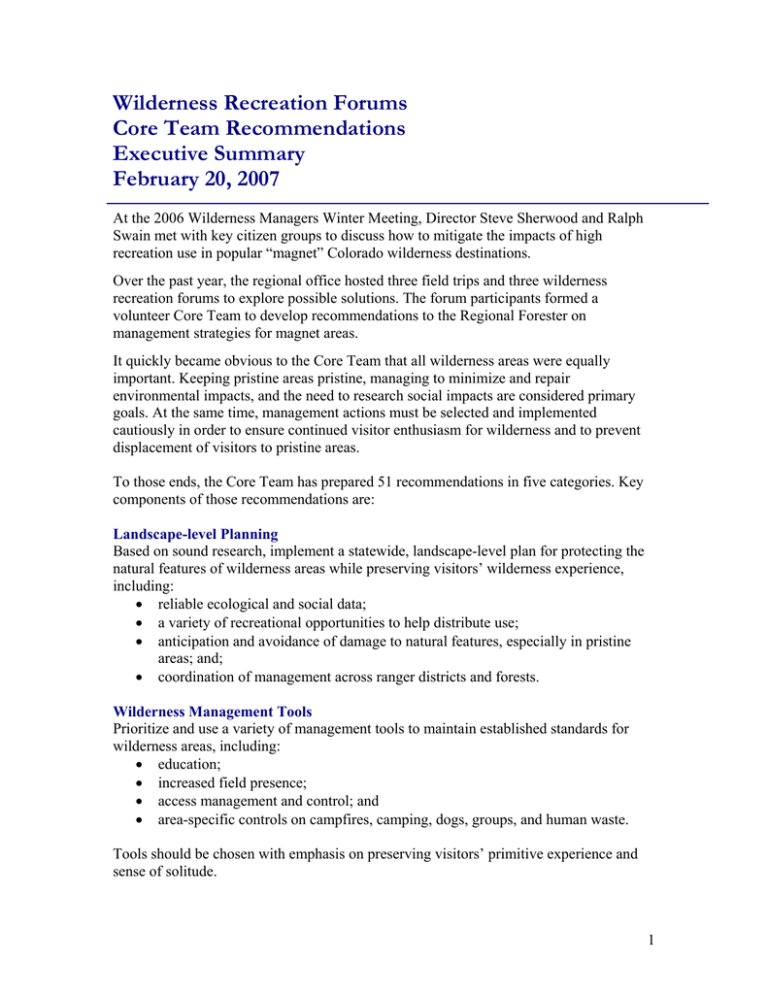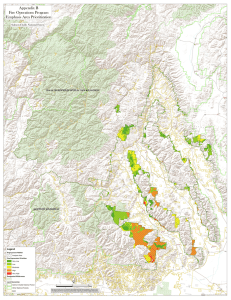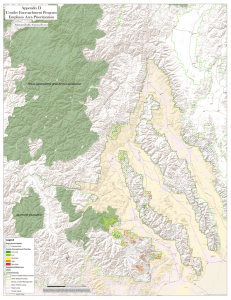Wilderness Recreation Forums Core Team Recommendations Executive Summary February 20, 2007
advertisement

Wilderness Recreation Forums Core Team Recommendations Executive Summary February 20, 2007 At the 2006 Wilderness Managers Winter Meeting, Director Steve Sherwood and Ralph Swain met with key citizen groups to discuss how to mitigate the impacts of high recreation use in popular “magnet” Colorado wilderness destinations. Over the past year, the regional office hosted three field trips and three wilderness recreation forums to explore possible solutions. The forum participants formed a volunteer Core Team to develop recommendations to the Regional Forester on management strategies for magnet areas. It quickly became obvious to the Core Team that all wilderness areas were equally important. Keeping pristine areas pristine, managing to minimize and repair environmental impacts, and the need to research social impacts are considered primary goals. At the same time, management actions must be selected and implemented cautiously in order to ensure continued visitor enthusiasm for wilderness and to prevent displacement of visitors to pristine areas. To those ends, the Core Team has prepared 51 recommendations in five categories. Key components of those recommendations are: Landscape-level Planning Based on sound research, implement a statewide, landscape-level plan for protecting the natural features of wilderness areas while preserving visitors’ wilderness experience, including: • reliable ecological and social data; • a variety of recreational opportunities to help distribute use; • anticipation and avoidance of damage to natural features, especially in pristine areas; and; • coordination of management across ranger districts and forests. Wilderness Management Tools Prioritize and use a variety of management tools to maintain established standards for wilderness areas, including: • education; • increased field presence; • access management and control; and • area-specific controls on campfires, camping, dogs, groups, and human waste. Tools should be chosen with emphasis on preserving visitors’ primitive experience and sense of solitude. 1 Magnet Wilderness Areas • greatly increase forest service presence. • avoid damage to natural features; • repair existing damage; and • avoid displacing excess use into pristine areas. Partnerships, Volunteers, and Education Establish, nurture, and fund partnerships with foundations and citizen organizations to enhance the Forest Service’s ability to manage and protect wilderness, with emphasis on increasing field presence and constructive educational contact with visitors. These partnerships and accompanying educational programs should be used to: • improve training and resources for Forest Service staff; • increase visitor awareness of low-impact, Leave No Trace use of wilderness areas and; • improve skills, funding opportunities and tools for partner groups. Funding and Revenue Funding for wilderness protection and management must be increased, particularly in the field, through: • increased Congressional appropriations for wilderness management; • detailed estimates of wilderness management costs; • careful regional accounting and allocations to ensure sufficient and reliable funding for wilderness management; and • strategic use of volunteers, partnerships, and supplemental revenues to enhance, but not replace, proper levels of agency funding for wilderness management. 2







